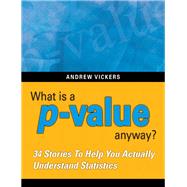What is a p-value Anyway? offers a fun introduction to the fundamental principles of statistics, presenting the essential concepts in thirty-four brief, enjoyable stories. Drawing on his experience as a medical researcher, Vickers blends insightful explanations and humor, with minimal math, to help readers understand and interpret the statistics they read every day.
What is a p-value Anyway? is the perfect complement to any introductory statistics textbook and will succeed in demonstrating the everyday importance of statistics to your class. When I started writing this book, I wondered whether I could write something about statistics that was fun, at least in places.
This is how I came up with the idea of stories; you hear a story to help you understand something and you'll remember it for life. Hopefully, after you have read this textbook, you'll have a good understanding of many of the key ideas of statistics. You'll also be able to avoid making some of the most common statistical mistakes and errors.
Describing data; Data distributions; Variation of study results: confidence intervals; Hypothesis testing; Regression and decision making; Some common statistical errors, and what they teach us
For all readers interested in statistics.








